
 Adult Reading Level
Adult Reading Level
Colonialism on Trial

 Adult Reading Level
Adult Reading LevelColonialism on Trial
|
Most books about a court struggle involving Indian land rights are academic hiustories or lawbooks -- necessary tools for lawyers or historians but rather dull reading. Not so this book, which is a work of art. Artist Don Monet's sketches and cartoons -- several on every page -- are an integral part of the exposition. Often he catches subtle or ironic legal points in a way that thousands of words couldn't do. Character sketches of traditional Native witnesses, younger supporters, the dramatis personae of lawyers, judges, other functionaries are much more telling than photos. Skanu'u (Gitskan researcher-writer, who covered it for Northern Native Broadcasting) and Monet were a good team, and have produced a book of lasting value which, in the way of many good Native books, is about to go out of print.
Wilson's drawing forms the cover and endpiece of an unusual, beautiful, book about the legal struggle, of 2 British Columbia Northwest Coast tribes, begun in 1977, and with a 3-year trial which started in 1987, which is now in appeal and probably ultimately on its way to the World Court at The Hague. Sales of the book, which is a kind of artist's eye view of the trial, the people, the issues, are helping to finance this.
The land, which became the subject of the 3-year lawsuit the book reports on, is located inland of Canada's northwest coast, somewhat north of Vancouver Island, centered by the valley of the Skeena River, with Gitksan traditional territories extending into mountains and valleys north, and Wet'suwet'en (formerly called Carrier Indians) territories to the south. The two tribes lived as friendly neighbors, divided by the river, in peace for 3,000 years. There was intermarriage and a common civilization, lifestyle, and culture, but each had its own complex traditional government and different languages.
This had no effect. At the end of the trial, the judge ruled: "The plaintiffs' ancestors had no written language, no horses or wheeled vehicles, slavery and starvation was not uncommon, wars with neighboring peoples wre common, and there is no doubt to quote Hobbes, that aboriginal life in the territory was 'nasty, brutish, and short.' " (Elders, who had bared histories, stories, songs, and symbols and methods of traditional Feaster government were shocked and hurt by this.) The same year the bridge was photographed, as the engineering marvel it was (there was expert testimony about this), miners, penetrating the area had burnt a Gitksan village and some totem poles. The Chiefs blocked the Skeena river to all trading and supply boats. A British squadron of gunboats attacked Indian villages in Clayoquet Sound, Eventually the Skeena Rebellion ended peacefully when some compensation was paid for the burned village. Meanwhile, though, gillnet fishing boats arrived downstream at the Skeena's mouth. By the end of the century, there was a cannery industry there. Native fishing rights downstream were abolished, and salmon runs upstream were no longer plentiful, but fishery was still a way of life and survival, inland toward the mountains. Hidden in the mists thrown up by rapids and waterfall, around a turn in the canyon, on either side, each tribe had its fishing platforms, houses and other structures facing each other. Most fishing was done by the women, from a large rock in the middle of the rapids, which fell into Hagwilget canyon during a large mountain avalanche in 1820. The Wet'suwet'en had moved closer to the river then, and the two tribes collaborated more closely on projects like the bridge and fishing together. In 1959, the federal Fisheries department blew up that fishing rock. Wet'suwet'en women tried to unsuccessfully stop this (when legal attempts to block it failed) by some mild rock throwing.
The point of testimony like this, (and many others), was to counter that part of the governmnt's case claiming that the Indians had not resisted, had accepted the reserve boundaries and takings of their land, had accepted the reservation and band system imposed by the government. There are no cession treaties, and aboriginal title had never been extinguished -- that's what they sued for, title recognition to the hereditary traditionally-demarcated lands. The government contended the acceptance of "many good things" brought by the white man and failure to use or defend or protest encroachments constituted an acceptance of title extinguishment. Unlike most other Indians in Canada, who had in fact been subjected to a lot of hasty cession-treaty extinguishments, this was never done in B.C. So the government's argument had to be that there did not exist any aboriginal title that required extinguishment, because the aborigines were incapable of such possessory rights. The government also argued that the Indians occupied and used only the main river valleys, that the land -- mountains and valleys beyond (which constituted most of the claim, the areas where clearcut loggers were active) had rarely even been visited by them, that the land was unused. (Aboriginal title is usufruct, usage title.) Therefore, the government contended, the Indians had no use for this land now, as logging companies and other developers did, and should not have title. To prove this, they put on such sleazy witnesses as hunting party guides who said they'd flown parties of white hunters into the back country several times and seen no Indians back there.
Chamlaxyeltxw (Solomon Marsden, of Ganeda Clan) testified that the traditional relationship to the back country is storage of resources, explaining why the traditional clan law was so severe on trespassers: "The Indian people Aluugigyet call their territories a storage place, An lu'u to'ost. Whenever they would need anything for survival, or whenever they want the resources, it's like opening a storage bin and taking what you need out of that, the storage place. And this is why they have a respect for the land, for survival." Yet Judge McEachern ruled: "The most striking thing that one notices in the territory away from the Skeena - Bulkley [river] corridor is its emptiness. I generally accept the evidence of witnesses such as Dr. Steciew [rich physician who owned a guide company and had tried to buy Indian trapline land], Mrs Peden [ran a hunter guide company] and others that very few Indians are to be seen anywhere except in the large river corridors...the territory is a vast emptiness." Even as he made this vast emptiness ruling based on false testimony about Indian non-presence, about 1/4 of the claim area had been pocked with logging clearcuts.
The elders' testimony really was clear enough. It was a message the judge and government don't want to hear: "When House Chiefs take a name, they take on the responsibilities that go with the name. One of them is to make sure that on the territory you have taken to protect, the people using it make sure there is no pollution and that the area the animals are using and game trails and beaver dams and fishing sites are free from any obstructions, and you have to make sure that the people using it don't clear out the animals that are there for reproduction."--Gisdaywa (testimony of Alfred Joseph Gitumden Clan, Tse Kya Village). A 3,000 year old traditional Native government that white governments and big industry do not want to see having the rights to do this land protction job.
During the first few months, the trial was held in Hazelton, on or near the claimed land. elder witnesses were able to attend, the Native law team had an office at relatively low cost, transportation and other costs were low. And of course there was a lot of local support, the trial was well attended every day. Then the judge said it was inconvenient for him and the government lawyers, so they moved it to Vancouver -- at a greatly increased cost to the Indian side, inability of most reservation people to attend, discomfort and health problems in long travel for elderly witnesses. Since there was very little press coverage, and the interested people (Indians) could not afford to attend, most of the trial was played out in a cavernous, empty Vancouver courtroom. (The small one near the reserves had been crowded every day -- mostly with Indians.)
About all this -- the ancient system of government, the hereditary rights and responsibilities to protect and manage land territories which were often defined or outlined in songs and legendary features -- the judge ruled: There was no aboriginal title, and "I am unable to accept adaawk, kungas, and oral histories as reliable bases for detailed history, but they could confirm findings based on other admissible evidence." Evidently he didn't consider science to be evidence. Whereas he did accept as evidence testimony of financially interested phonies such as an "expert" whose only credentials were that she belonged to a recreational group that checked out old sunken boats for treasure, which she called underwater archaeology. The judge himself displayed a weird superstition in his decision-statement: " 'Time immemorial' as everyone knows, is a legal expression referring to the year 1189 (the beginning of the reign of Richard II)." So the struggle of these two ancient nations continues, both in appellate court and via direct action. Author Skanu'u (Ardythe Wilson) writes: "The reality is that we have never given up, never sold, never lost in battle, our ownership and jurisdiction to our own territories. Our right and title is inherited from our ancestors who lived and governed themselves for thousands of years .... The reality is that our societies, our culturs, and our systems are alive and well. They have sustained us through 150 of the darkest, most destructive years our people have known, and will continue to sustain us as we resume our right to be self-sufficient, self-reliant, and self-governing." Beautiful, funny, sad, unique. This book uses the power of art to show certain realities -- including laughter that one reviewer called "a humor that for now is more bitter than sweet". It conveys a history, a culture, and an environmental world-view that are very little known in the U.S. and has been much misrepresented in the past (potlatch), as well as the progress and governmental stupidities of the lawsuit. Its presentation via many drawings and cartoons, with excerpts from testimony, articles summarizing and setting the stage, historical context in outline form is a unique approach to complex matters that, here, many young people can easily follow. Very highly recommended for adults, Native or Environmental Studies, and high school students. Reviewed by Paula Giese What's happening now? The lawsuit's in appeal. Don Monet is working as an artist and political cartoonist in Toronto and has a web page displaying a cartoon-a-day (including quite a few Native ones) as well as his paintings. Wet'suwet'en kids in Smithers school have page of computer projeect history, continuing traditional learning in a modern way. Check it out on maziniaajim, the picture story page record: 522, file colonial.html
Purchase this book now from |
|---|
 BOOK Menu
BOOK Menu COLONIALISM ON TRIAL: INDIGENOUS LAND RIGHTS AND THE GITKSAN AND WT'SUWET'EN SOVEREIGNTY CASE, Don Monet and Skanu'u (Ardythe Wilson), New Society Publishers, 4527 Springfield Avenue, Philadelphia, PA 19143. 800-333-9093, 1992, 212 Pages, paperback oversize, photo essay, many drawings, cartoons, maps, chronology of Canadian Indian history $10.
COLONIALISM ON TRIAL: INDIGENOUS LAND RIGHTS AND THE GITKSAN AND WT'SUWET'EN SOVEREIGNTY CASE, Don Monet and Skanu'u (Ardythe Wilson), New Society Publishers, 4527 Springfield Avenue, Philadelphia, PA 19143. 800-333-9093, 1992, 212 Pages, paperback oversize, photo essay, many drawings, cartoons, maps, chronology of Canadian Indian history $10.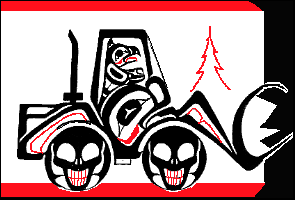 "Luulak was concerned about the destruction of the forest [by loggers] on her territory. So the Chiefs held a meeting at Gitwangak and decided to seize or burn the equipment being used there. When we got to the site, we decided to take the front-end loader. An Eagle Chief hot-wired it -- you can see him driving it away. The body of the vehicle is depicted as a frog, because Luulak is a Frog [clan] chief, and we seized the vehicle on her behalf. The skulls in the wheels represent Luulak -- the ghost." -- Wii Mugulshw, aka Art Wilson, Gitksan artist-carver
"Luulak was concerned about the destruction of the forest [by loggers] on her territory. So the Chiefs held a meeting at Gitwangak and decided to seize or burn the equipment being used there. When we got to the site, we decided to take the front-end loader. An Eagle Chief hot-wired it -- you can see him driving it away. The body of the vehicle is depicted as a frog, because Luulak is a Frog [clan] chief, and we seized the vehicle on her behalf. The skulls in the wheels represent Luulak -- the ghost." -- Wii Mugulshw, aka Art Wilson, Gitksan artist-carver Woodcarver Wilson stands on a clear-cut hillside of his own clan's wounded land. Logging companies have pulled down the forest and left hillsides dirt-bare and covered with dead trash, once trees. The rivers run with mud as the soil -- built up over eons -- erodes into them, killing the fish on which the two adjacent, British Columbia inland tribes have depended for 3,000 years or more. The othr wildlife dies. There are huge patches of desolation like this, dead trees and stumps everywhere, where once were forested hills and valleys. The two tribes continue the expensive litigation (having lost a 3-year trial) and begin to undertake direct action, as Art described, to stop the clearcutting.
Woodcarver Wilson stands on a clear-cut hillside of his own clan's wounded land. Logging companies have pulled down the forest and left hillsides dirt-bare and covered with dead trash, once trees. The rivers run with mud as the soil -- built up over eons -- erodes into them, killing the fish on which the two adjacent, British Columbia inland tribes have depended for 3,000 years or more. The othr wildlife dies. There are huge patches of desolation like this, dead trees and stumps everywhere, where once were forested hills and valleys. The two tribes continue the expensive litigation (having lost a 3-year trial) and begin to undertake direct action, as Art described, to stop the clearcutting.
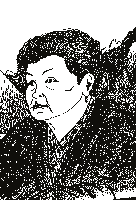 Elder Yaga'lahl (Dora Wilson, leader of a clan) described her own presence and that of her mother and aunts in attempting to stop the dynamiting of the fishing rock: "My grandmother, my aunt and quite a number of the women went down to the bridge and pelted those workers down below with rocks, tried to get them to stop. We don't get any fish any more now from that canyon. You know, during our Feasts [so-called Potlatches that were outlawed by the Canadian government] sometimes some of our personal debts that we pay up then concern fish that's given to us."
Elder Yaga'lahl (Dora Wilson, leader of a clan) described her own presence and that of her mother and aunts in attempting to stop the dynamiting of the fishing rock: "My grandmother, my aunt and quite a number of the women went down to the bridge and pelted those workers down below with rocks, tried to get them to stop. We don't get any fish any more now from that canyon. You know, during our Feasts [so-called Potlatches that were outlawed by the Canadian government] sometimes some of our personal debts that we pay up then concern fish that's given to us."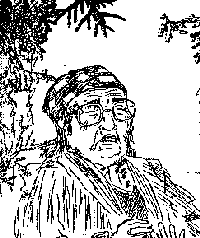 Countering this contention that Indians didn't use the back country, Elder Kweese (Florence Hall) was one of many who testified: "There's a lot of sentimental value and reasons in that territory. Because of that territory most of our elders have, through hardship, passed on. Every time there is a death in the clan and a feast to be conducted, they all went out on the territory to prepare for a feast." Tachwok (James Morrison), Lach Gibuu Clan Elder, testified about songs that memorialized the land, that such songs brought to life the past and the territory itself: "I can still feel it today, while I'm sitting here [in court], I can hear the brook, I can hear the river run. This is what the song is all about. You can feel the air of the mountain. This is what the song is. To bring your memory back to that territory. If you know the territory well, it is like your own skin. Sometimes you can even feel animals moving on your body as they are on the land, the fish swimming in your bloodstream. "
Countering this contention that Indians didn't use the back country, Elder Kweese (Florence Hall) was one of many who testified: "There's a lot of sentimental value and reasons in that territory. Because of that territory most of our elders have, through hardship, passed on. Every time there is a death in the clan and a feast to be conducted, they all went out on the territory to prepare for a feast." Tachwok (James Morrison), Lach Gibuu Clan Elder, testified about songs that memorialized the land, that such songs brought to life the past and the territory itself: "I can still feel it today, while I'm sitting here [in court], I can hear the brook, I can hear the river run. This is what the song is all about. You can feel the air of the mountain. This is what the song is. To bring your memory back to that territory. If you know the territory well, it is like your own skin. Sometimes you can even feel animals moving on your body as they are on the land, the fish swimming in your bloodstream. " 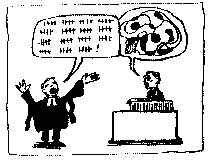 Traditional witnesses -- clan elders -- testified about a history of self and land-governance and knowledge thousands of years old. The court could not cope with their methods of knowledge and expression -- as this cartoon (a lawyer reciting tally-numbers and a traditionalist expressing imagistic thoughts) showed. The judge repeatedly spoke of "folktales" saying they were not evidence. Some elders know the governance and land boundaries systems in part as songs -- and only with reluctance (once) did the judge allow an elder woman to sing one song.
Traditional witnesses -- clan elders -- testified about a history of self and land-governance and knowledge thousands of years old. The court could not cope with their methods of knowledge and expression -- as this cartoon (a lawyer reciting tally-numbers and a traditionalist expressing imagistic thoughts) showed. The judge repeatedly spoke of "folktales" saying they were not evidence. Some elders know the governance and land boundaries systems in part as songs -- and only with reluctance (once) did the judge allow an elder woman to sing one song.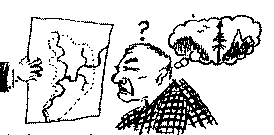 This cartoon captures a difficulty the plaintiffs had in showing both the area of the claim and the traditional hereditary governance territories within it. The cartographer the tribes had employed was cross-examined by government as to why the map had been changed between 1977 when it was first made and the introduction in court of map evidence, 1988. They were trying to show the Indians didn't really know these territories. The cartoon captures the communication problem the cartographer had to find ways around, in map-making. The people see the land as they walk it, in its full sensory beauty. The cartographer must show it from an aircraft-like bird's eye view, in linear abstraction.
This cartoon captures a difficulty the plaintiffs had in showing both the area of the claim and the traditional hereditary governance territories within it. The cartographer the tribes had employed was cross-examined by government as to why the map had been changed between 1977 when it was first made and the introduction in court of map evidence, 1988. They were trying to show the Indians didn't really know these territories. The cartoon captures the communication problem the cartographer had to find ways around, in map-making. The people see the land as they walk it, in its full sensory beauty. The cartographer must show it from an aircraft-like bird's eye view, in linear abstraction.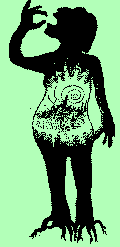 The elder traditional witnesses were mostly hereditary clan leaders, with both inheritances and long periods of learning. They all stressed the mutual relationship between people -- who are fed by the land -- and of their own traditional work, customs and laws in feeding, taking care of, protecting and preserving the land, animals, waters. Tenimgyet (Art Mathews) testified that at feasts (a part of both government and religion), food taken from the territories has its place of origin called out as it is served. When you digest this food, you are affirming the source place, and it in turn affirms you. He described clearcut logging going on in the territories: "When you clearcut the very word means they cut everything down right from the underbrush to the very food, you might way, of these moose, like poplar. It's not utilized in any way, shape or form, just cut down and burnt."
The elder traditional witnesses were mostly hereditary clan leaders, with both inheritances and long periods of learning. They all stressed the mutual relationship between people -- who are fed by the land -- and of their own traditional work, customs and laws in feeding, taking care of, protecting and preserving the land, animals, waters. Tenimgyet (Art Mathews) testified that at feasts (a part of both government and religion), food taken from the territories has its place of origin called out as it is served. When you digest this food, you are affirming the source place, and it in turn affirms you. He described clearcut logging going on in the territories: "When you clearcut the very word means they cut everything down right from the underbrush to the very food, you might way, of these moose, like poplar. It's not utilized in any way, shape or form, just cut down and burnt."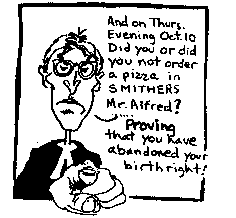 The government based part of their case on the idea that the Indians weren't really Indians any more if they had adopted or adapted to anything at all that is western or different from how things were in 1700. This cartoon shows a typical accusation. Other traditionals were accused of making wills (the DIAND disclosed to the government all the private papers about wills and estates), of fighting to get decent schools on the reservation for their youth, of shopping at small stores located on the reservation.
The government based part of their case on the idea that the Indians weren't really Indians any more if they had adopted or adapted to anything at all that is western or different from how things were in 1700. This cartoon shows a typical accusation. Other traditionals were accused of making wills (the DIAND disclosed to the government all the private papers about wills and estates), of fighting to get decent schools on the reservation for their youth, of shopping at small stores located on the reservation.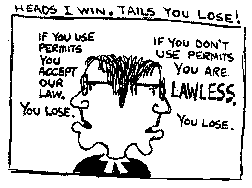 Elders were caught in an evidentiary double-bind, as shown in this cartoon regarding whether they did or did not hunt or fish with government permits. (That's the problem with the wills, too. If they followed their traditional inheritances, they wouldn't make wills -- but it wouldn't have been recognized by BC.) And then the judge ruled (for the so-called empty lands): "the aboriginal activities that are being pursued now may be indistinguishable in many cases from the wilderness activities enjoyed by many non-Indian citizens of the province."
Elders were caught in an evidentiary double-bind, as shown in this cartoon regarding whether they did or did not hunt or fish with government permits. (That's the problem with the wills, too. If they followed their traditional inheritances, they wouldn't make wills -- but it wouldn't have been recognized by BC.) And then the judge ruled (for the so-called empty lands): "the aboriginal activities that are being pursued now may be indistinguishable in many cases from the wilderness activities enjoyed by many non-Indian citizens of the province."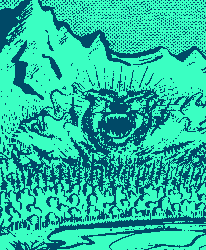 Toward the end, some scientific expert witnesses were put on. Geomorphologists testified that the so-called folklore, traditional stories and songs of the country's being formed by a giant grizzly bear, rampaging down the valley, tearing up the forest, were scientifically provable. A huge landslide occurred there 3600 years ago, pouring down the mountains, tearing up the forest, fanning out, damming an area that formed a lake. "Did you also assume that such occurrences may be ascribed either to supernatural events or extraordinary physical events, depending on cultural perspective?" asked a lawyer. "Yes, that's my assumption," geomorphologist Alan Gottesfield testified. He attempted to explain that if you were far enough from the avalanche and slide to survive, seeing the avalanche of rocks, mud, torn trees, rushing down, roaring might well have seemed like a giant grizzly tearing up the countryside. The government objected he was not an expert in the seeing of such a thing. Artist-co-author Don Monet captures the picture that expresses what science explains and tradition sings of.
Toward the end, some scientific expert witnesses were put on. Geomorphologists testified that the so-called folklore, traditional stories and songs of the country's being formed by a giant grizzly bear, rampaging down the valley, tearing up the forest, were scientifically provable. A huge landslide occurred there 3600 years ago, pouring down the mountains, tearing up the forest, fanning out, damming an area that formed a lake. "Did you also assume that such occurrences may be ascribed either to supernatural events or extraordinary physical events, depending on cultural perspective?" asked a lawyer. "Yes, that's my assumption," geomorphologist Alan Gottesfield testified. He attempted to explain that if you were far enough from the avalanche and slide to survive, seeing the avalanche of rocks, mud, torn trees, rushing down, roaring might well have seemed like a giant grizzly tearing up the countryside. The government objected he was not an expert in the seeing of such a thing. Artist-co-author Don Monet captures the picture that expresses what science explains and tradition sings of.